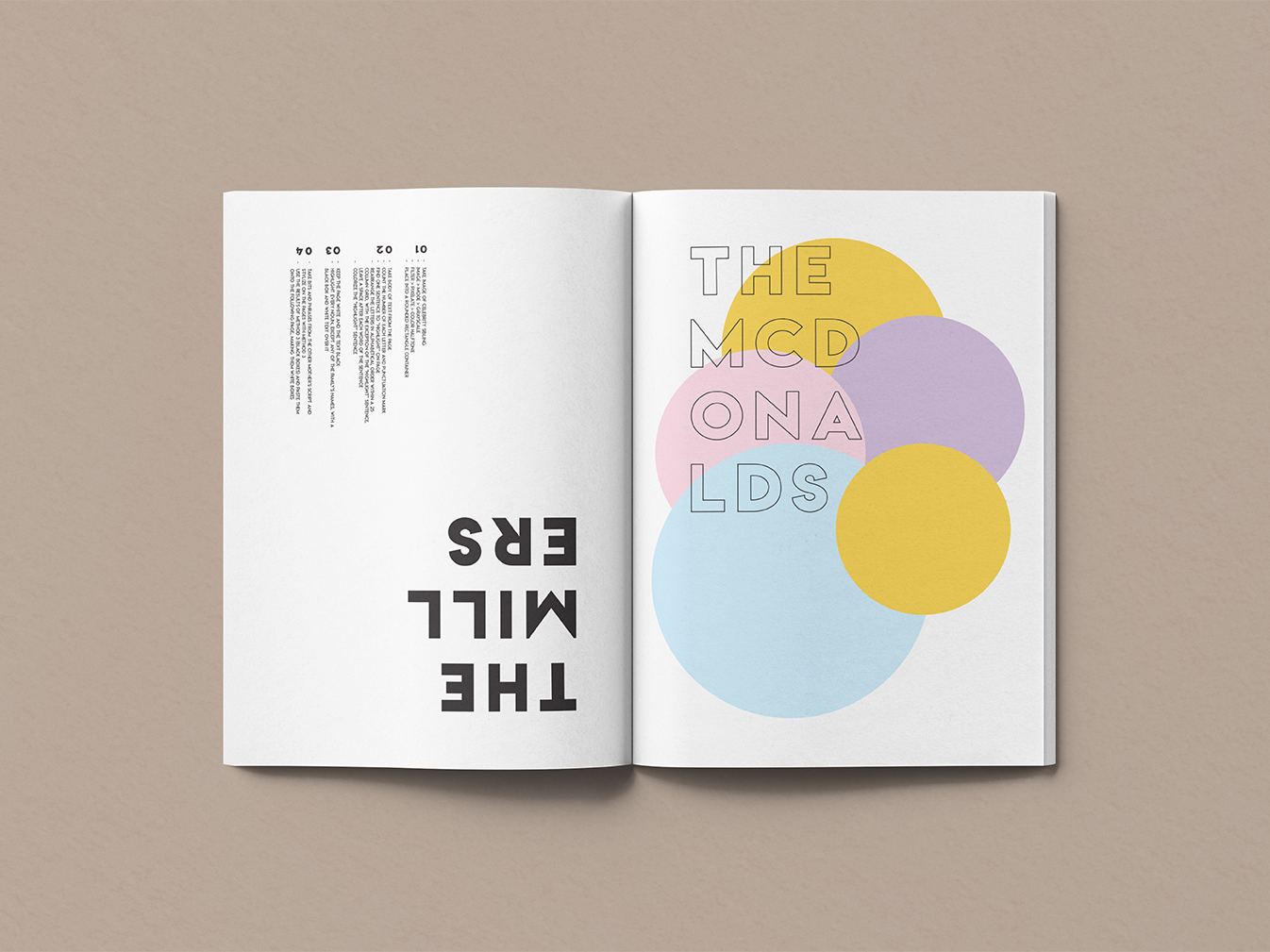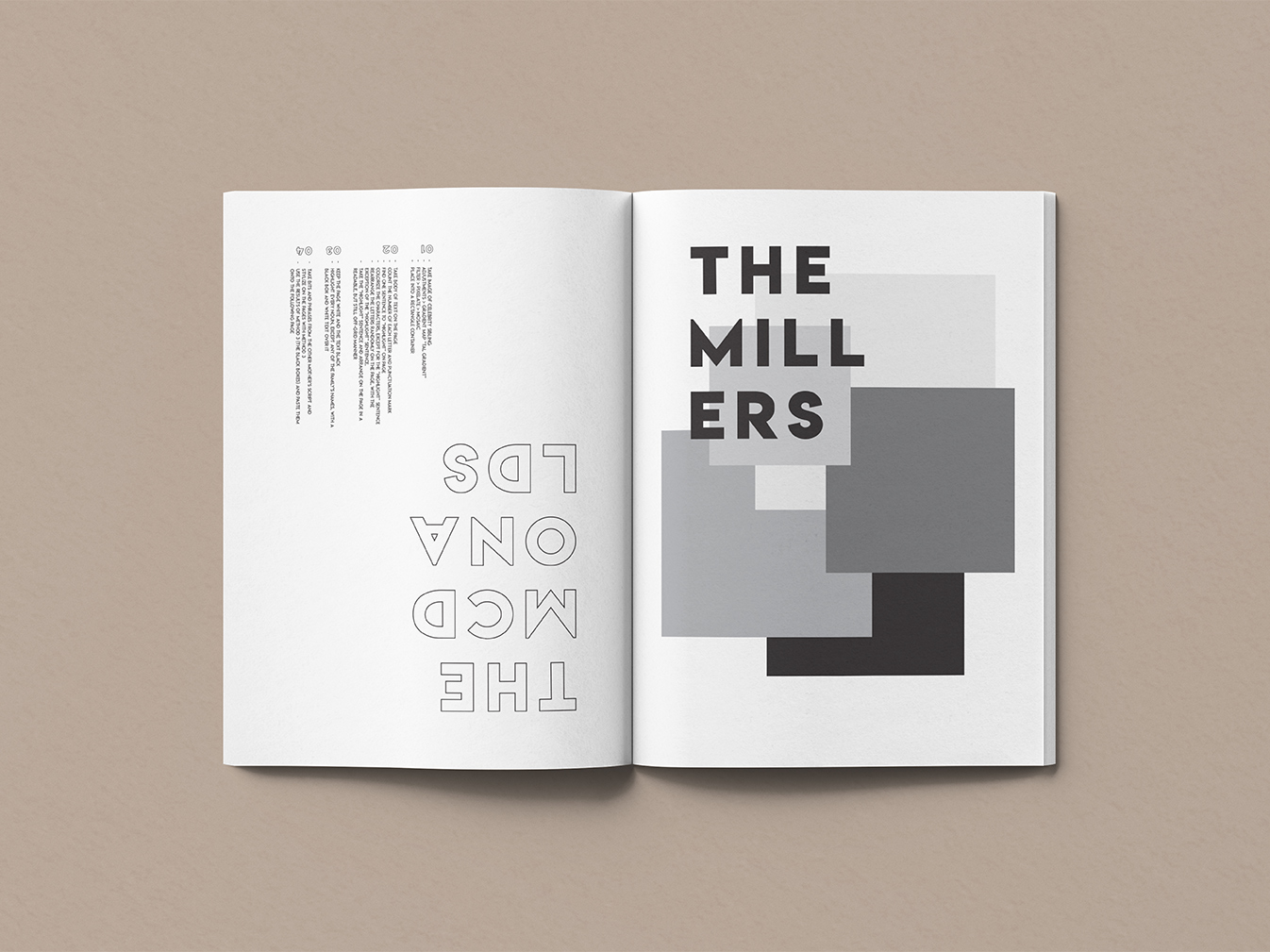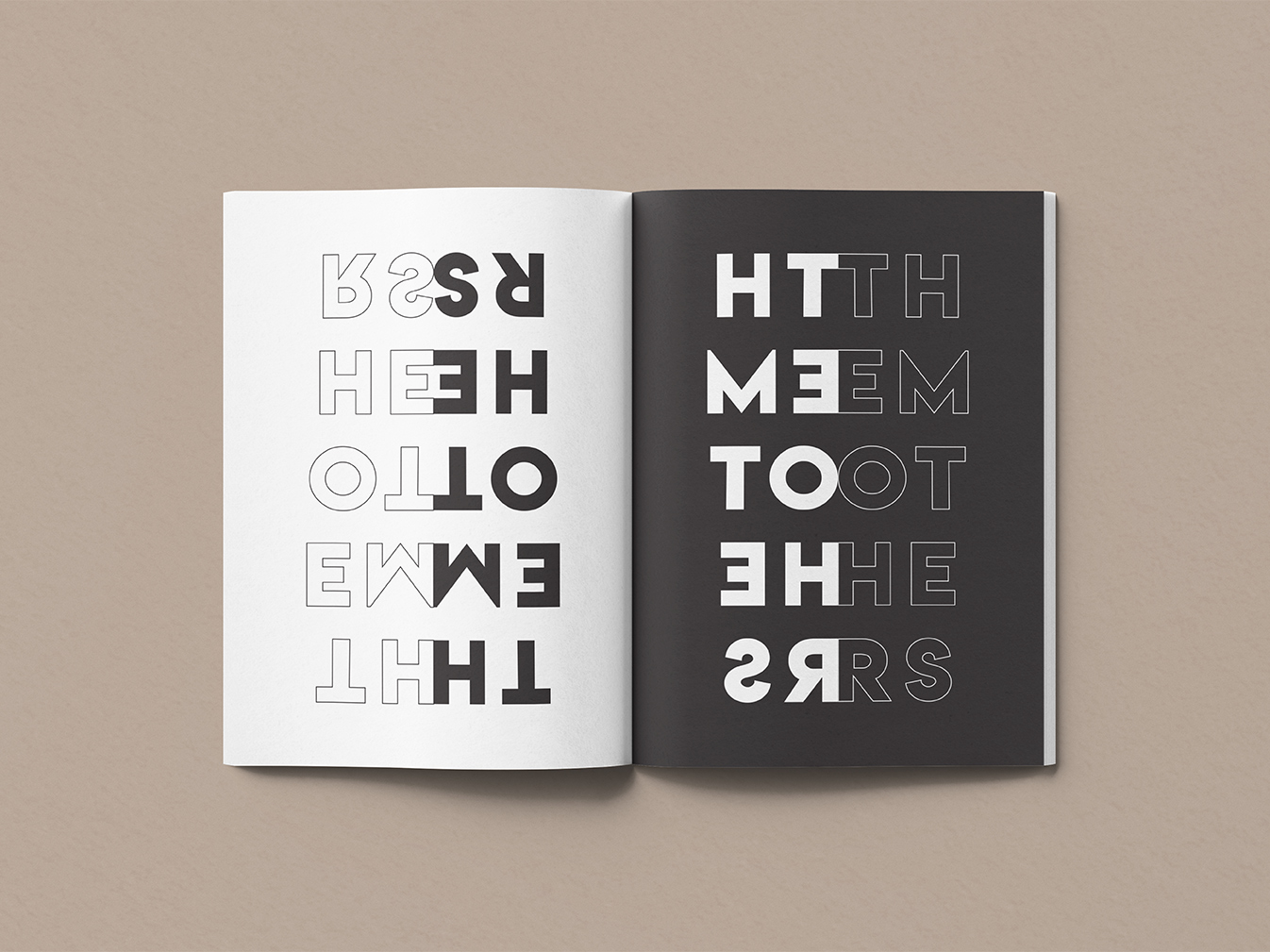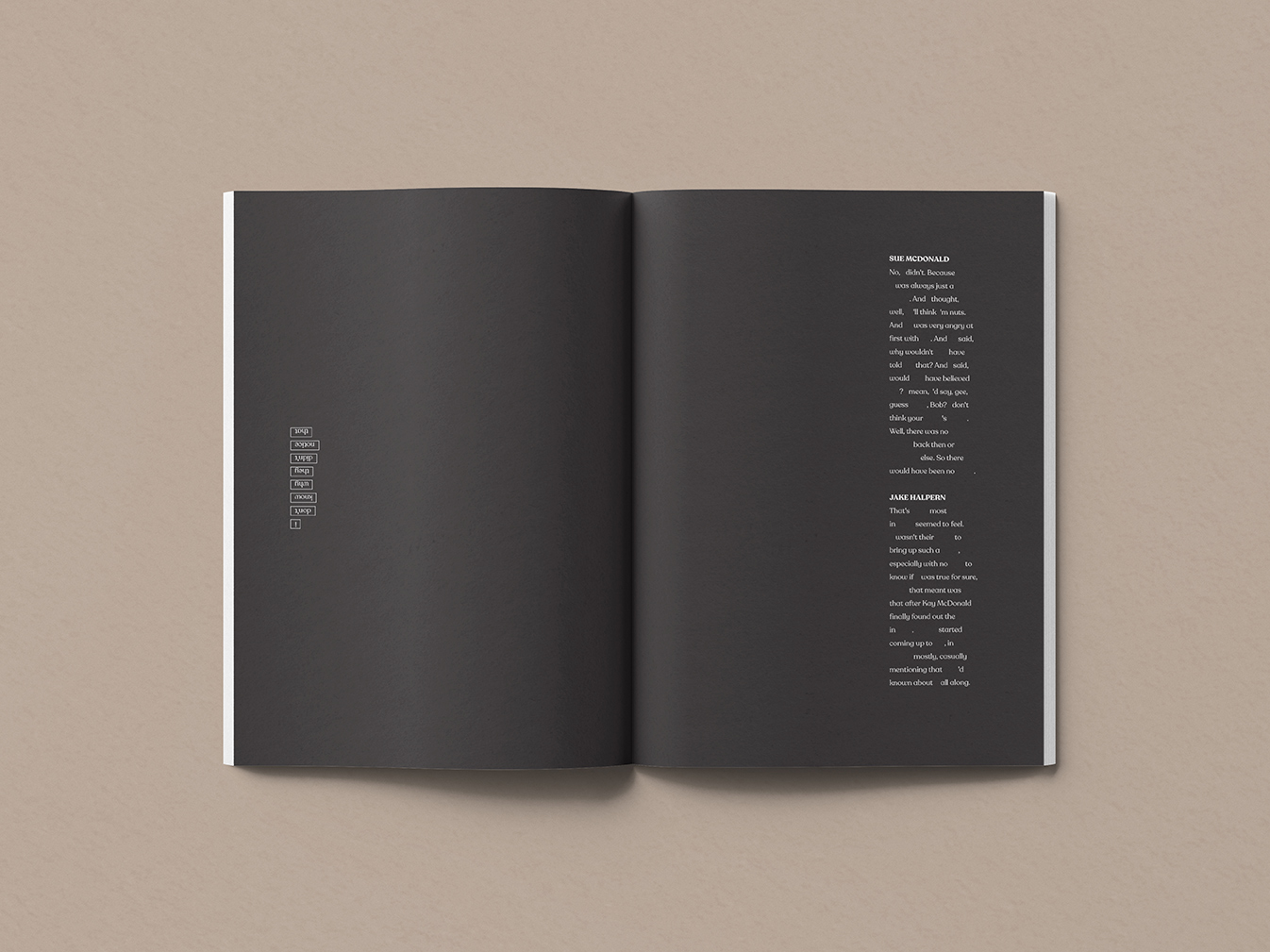project type ─
Editorial Design

specs ─
7" x 10" (closed)

medium ─
printed book
episode description ─
"On a summer day in 1951, two baby girls were born in a hospital in small-town Wisconsin. The infants were accidentally switched, and went home with the wrong families. One of the mothers realized the mistake but chose to keep quiet. Until the day, more than 40 years later, when she decided to tell both daughters what happened. How the truth changed two families' lives—and how it didn't." ─This American Life Ep.360
project details ─
"Switched at Birth" can be read from either ends of the book, with each side telling the story and perspective of one family - McDonald vs. Miller. Retrace the out-of-place childhood journey from both daughters. Step into Mrs. McDonald's story while important information is withheld. Try to understand Mrs. Miller's reasoning for not telling the family, even when the important information is clearly highlighted in front of you.
This book was born out of an exploration on the notion of story-telling through the "retelling" of an entire episode of This American Life. Using the transcript from episode 360, I dissected the podcast script and information by giving attention to the development of the narrative, the building of ideas, and the emotional arch of each act. From this dissection, I gave visual form to the content through the use of words and images that were constructed from developing a series of methodologies. These methodologies were crafted to reflect the storyline of the podcast episode and considered through four cateogries of image-making, color, composition, and typography.
Further details of execution can be found below, alongside other photographed documentation of the book.
You can listen here to the original recording of episode 360, "Switched At Birth."




McDonald vs. Miller
"The McDonalds are the light-haired ones from the letter. And it is a much smaller family, just two kids. And the feeling in their house was very different from the feeling in the Miller's house. They were easygoing quick to laugh and joke around. Mr. McDonald ran the TV repair shop in town."
The McDonalds are rendered as circles and in color to represent their bright and free-flowing personalities.

"The Millers are the bespectacled, dark-haired ones from the letter. Mrs. Miller's husband, the Reverend Norbert Miller, was an evangelical preacher, devoted to the church. And they were a bookish, serious bunch. This was a house with a lot of rules. And there were a lot of kids too. Seven kids in all."
The Millers are rendered as squares and in grayscale to represent their more serious and strict personalities.





The Daughters
Much of the design for the daughters is centrally themed on Sue and Marti's contrasting qualities within their families — boxy vs. rounded typography, black vs. color, circle half-tones vs. mosaic pixellation of photos, square vs. round shapes, their personalities vs. their familial upbringings. For Sue (the biological Miller daughter), her narrative stands square and black in comparison to colorful and round characteristics of an unstructured composition. For Marti (the biological McDonald daughter), her narrative is the opposite — bright and round in comparison to the rigid and black characteristics of an organized composition.












The Mothers
The design for the mothers takes a different approach from the daughters because it focuses more on the knowledge of truth (Mrs. Miller) and having truth withheld (Mrs. McDonald). The theme of black and white in this section has new a separate meaning from the daughters' section — this time, the black/white is used to portray Mrs. McDonald being kept in the dark, while Mrs. Miller was in the light because she knew the whole truth. As nouns can be considered a fundamental element in forming sentences, there are pages where every noun of Mrs. McDonald's story is blacked out and every noun of Mrs. Miller's story is highlighted because while Mrs. McDonald didn't know the important truth, Mrs. Miller was daily reminded of the truth that she withheld. The pages alternate between continuing their perspective and commenting about the other mother/their experience.










The Methodologies in Detail
McDonalds
- Method 1 - Daughters
- take image of celebrity sibling
- adjustments > gradient map "TAL GRADIENT"
- filter > pixelate > mosaic
- place into a rectangle container
- Method 2 - Daughters
- take body of text on the page
- count the number of each letter and punctuation mark
- find ONE sentence to "highlight" on page
- colorize the characters, except for the "highlight" sentence
- rearrange the letters randomly on the page, with the exception of the "highlight" sentence
- take the "highlight" sentence and arrange on the page in a readable, but still off-grid manner, making it black and white
- Method 3 - Mothers
- keep the page black and the text white
- cover up every noun, except any of the family's names, with a black box
- Method 4 - Mothers
- take bits and phrases from the other mother's script and stylize on the pages with method 3
- use the results of method 3 (the black boxes) and paste them onto the following page

Millers
- Method 1 - Daughters
- take image of celebrity sibling
- image > mode > grayscale
- filter > pixelate > color halftone
- place into a rounded rectangle container
- Method 2 - Daughters
- take body of text on the page
- count the number of each letter and punctuation mark
- find ONE sentence to "highlight" on page
- colorize the characters, except for the "highlight" sentence
- rearrange the letters in alphabetical order within a 25 column grid, with the exception of the "highlight" sentence. leave a space after each word of the sentence
- colorize the "highlight" sentence
- Method 3 - Mothers
- keep the page white and the text black
- highlight every noun, except any of the family's names, with a black box and white text over it
- Method 4 - Mothers
- take bits and phrases from the other mother's script and stylize on the pages with method 3
- use the results of method 3 (the black boxes) and paste them onto the following page


